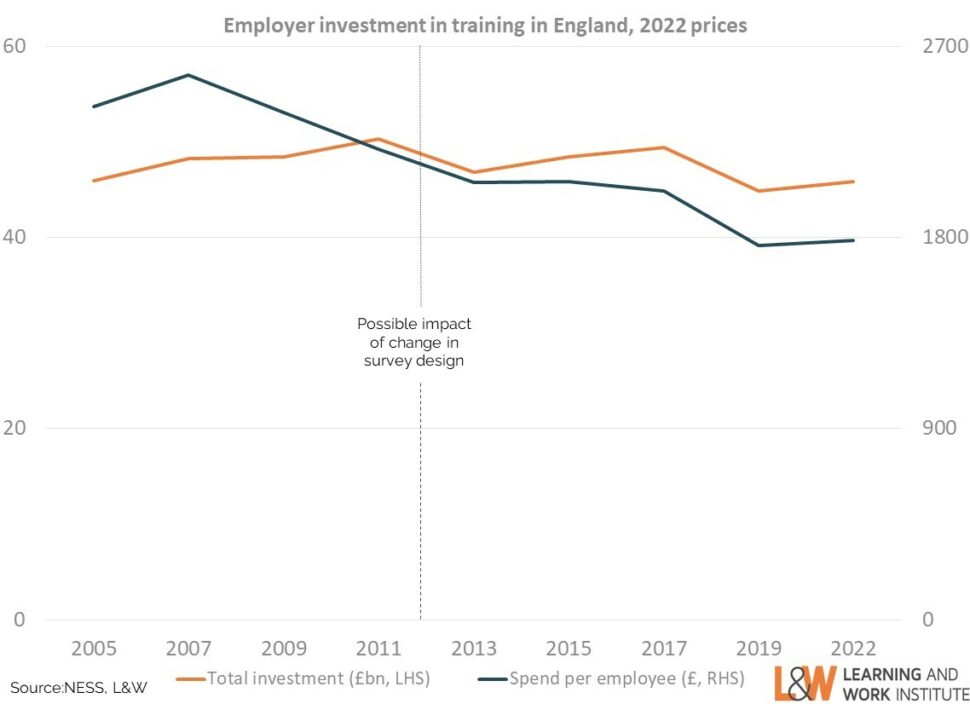The amount of money spent on training in England has flatlined as UK-wide spending sinks to its lowest ever recorded level, according to the government’s latest employer skills survey.
The report, published today by the Department for Education, sought out data on labour market and skills challenges faced by employers across the four nations.
Nearly 73,000 employers across England, Wales and Northern Ireland took part in the biennial survey for 2022. Data collection took place between June 2022 and March 2023.
Here are the key findings…
Investment in training flatlines
Employers in the UK spent less on training and development than in the previous 12 months.
Total employer expenditure was £53.6 billion in 2022, a 7.7 per cent real terms decrease from the last reported figure in 2017, which was £58.1 billion. In 2011, when data collection began, employers spent £59.1 billion on training.
Training expenditure in England increased slightly since 2019 from £44.9 billion to £45.8 billion.

Employers with five to 24 employees spent the most as a cohort on training – £16.65 billion in 2022 which is a decrease from 2017, when they spent £18.1 billion on staff training.
Large employers (with 100 plus employees) spent £14.7 billion on training in 2022, a decline from the £16 billion spent in 2017.
According to the latest figures, the average investment in training per employee in England was £2,971, plummeting 27 per cent since 2011 when £4,095 was spent per employee (adjusted for inflation).
Stephen Evans, chief executive of the Learning and Work Institute, said today’s figures show the amount employers in England invest in training “continued to flatline.”
Fewer employers are providing training
The survey also found that 60 per cent of companies funded or arranged any training for staff over the past 12 months in England, a drop from 66 per cent in 2017, and 61 per cent in 2019.
Figures show there was a decrease in UK employers providing training in all sectors, apart from the public administration sector. The largest decreases were seen among manufacturing employers (decreasing six percentage points in 2017 to 54 per cent in 2022), and arts and other services sectors (falling eight percentage points in 2017 to 60 per cent in 2022).
Larger employers were more likely to provide training over SMEs – 94 per cent among companies with 250 or more employees compared to 45 per cent in firms with two to four employees.
In 2022, around half (49 per cent) of UK employers provided on-the-job training to their staff over the past 12 months; down from 53 per cent in 2017.
Furthermore, the proportion of employers providing off-the-job training fell nine percentage points from 2017 to 39 per cent in 2022.
Around one in five (21 per cent) UK employers offered on-the-job training only, rising from 18 per cent in 2017.
Skills-shortage vacancies growing
More employers are reporting having a skill-shortage vacancy – defined as a hard-to-fill vacancy due to a lack of skills, qualifications or experience among applicants.
In 2022, 10 per cent said they have a skill-shortage vacancy, higher than in 2017, when 6 per cent of employers reported so.
Additionally, more of the UK workforce was not fully proficient in their jobs, i.e. a skills gap.
The proportion of employers that had at least one member of staff with a skills gap was 15 per cent, slightly higher than 13 per cent of employers in 2017.
The percentage of skill-shortage vacancies as a proportion to vacancies in England was 36 per cent, a 14-percentage point increase from the 22 per cent skill-shortage vacancy density reported in 2017.
Education sector among the hardest to fill vacancies
Employers also reported difficulties filling roles, for reasons such as low numbers of applicants with the required skills, a lack of interest in the job, competition from other employers and poor terms and conditions offered for the post.
These so-called hard-to-fill vacancies were most prevalent among employers in the health and social work (26 per cent had at least one hard-to-fill vacancy), 26 per cent of education employers and 21 per cent of hotels and restaurants sector firms.
“We need a clear plan for economic growth and better incentives for employers to invest in skills, such as a skills tax credit and improved apprenticeship levy,” Evans said. “Our analysis suggests improving skills could boost the economy by £20 billion per year.”









So many questions here
Are employers delivering less training and growing from within?
Lack of training due to money constraints?
Looking to hire direct with the skills for the roles?
Hi Rob,
I happen to work for the lead data collection agency for this (IFF Research Ltd)
You can find the full report at Gov.uk here
https://assets.publishing.service.gov.uk/government/uploads/system/uploads/attachment_data/file/936488/ESS_2019_Summary_Report_Nov2020.pdf
Also, the microsite for the survey with FAQs and the above link here
https://www.skillssurvey.co.uk/